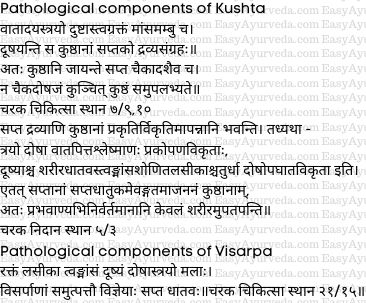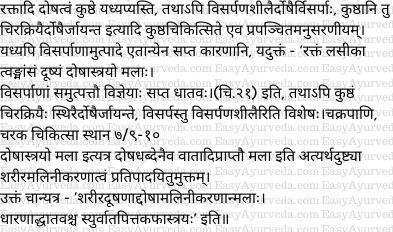Difference Between Kushta And Visarpa
By Dr Raghuram Y.S. MD (Ay) & Dr Manasa, B.A.M.S
Kushta and Visarpa are the diseases frequently encountered in clinical practice. Both are different diseases. Kushta is a group of skin disorders and 18 different types have been explained. They manifest in 11 minor and 7 major forms. Kushta is compared to skin diseases in general and leprosy to be specific. But going through its types we can see that different kinds of skin disorders have been enumerated under this topic.
Read – Charak Samhita Kushta Chikitsa – 7th Chapter

Visarpa is manifested in 7 different ways, which forms 7 types of visarpa. It has an external and internal manifestation. The types caused by combination of 2 doshas and all three doshas have been highlighted in the treatises. These are difficult to handle clinically as per Ayurveda. Visarpa is compared to herpes. But in spite of both these diseases being different entities why are we discussing the differences between them in this article? This is because they have a similarity in the way they manifest. The elements involving in the pathogenesis of both these diseases are the same. In spite of having the same pathological elements leading to their causation why one disease is called as Kushta and the other called as Visarpa? This is a point of discussion here. We need to know this to understand the nature of diseases which manifest in different ways in spite of having the same causative elements in common. This will help in diagnosing these conditions properly and treating them comprehensively.
Read – Visarpa: Causes, Types, Treatment, Medicines
Table of Contents
Kushta and Visarpa from components of pathogenesis points of view
1. Pathological components of Kushta
The Sapta Dravya Samgraha 7 components necessarily participate in the manifestation of kushta –
- Vata
- Pitta
- Kapha
- Twak – skin
- Rakta – blood
- Mamsa – muscle
- Ambu / Lasika – serum / lymph / fluid component of the body
These 7 components are considered as sapta dravyas of the pathogenesis of kushta. It is mandatory that all these components are involved in causation of the disease. Due to permutation and combination of these components 7 (maha kushta – major skin diseases) or 11 (kshudra kushta – minor skin diseases) kushtas are formed. No skin disease is manifested from single dosha. This means to tell that all types of kushtas are formed by the involvement of all three morbid doshas.
Master Charaka has quoted the same in the 5th chapter of Nidana Sthana dealing with etio-pathogenesis of Kushta. The below mentioned 7 components are the causes of kushta when they are in a state of vitiation. They are –
- the three doshas – vata, pita and kapha
- the four tissues – skin, blood, muscles and lymph / fluid component of the body – which are vitiated by the aggravated doshas
These components get aggravated together and cause many types of kushta. The skin diseases produced by these factors would spread all over the body and trouble the patient.
It is important to note that Master Charaka has used the term ‘lasika’ in Nidana Sthana and ‘ambu’ in Chikitsa Sthana. Hence both needs to be taken as the same component – synonymous of each other.
Read – Dhatu – 7 Body Tissues As Explained In Ayurveda
2. Pathological components of Visarpa
The pathological components which leads to the causation of visarpa are –
- Rakta – blood
- Lasika – lymph / plasma
- Twak – skin
- Mamsa – muscles
- Vata
- Pitta
- Kapha
The first four are dushyas i.e. tissues which are contaminated. The last three are doshas. The aggravated doshas vitiate these tissues. All these 7 components together, lead to the manifestation of visarpa.
Sanskrit verses


Comparison between the pathological components of Kushta and Visarpa
If we compare the components mentioned in Kusta and Visarpa, it is the same 7 components which cause both kushta and visarpa. Master Charaka has just changed the chronology of mentioning these components. In case of Visarpa he has mentioned the tissues involved in the pathogenesis of visarpa first and later the doshas. On the other hand he has first mentioned the doshas and later the tissues. But this doesn’t make any difference. The components are the same.
Master Chakrapani gives the clarification for the same in his commentary (Cha.Chi.21/15) taken from the chapter dealing with treatment of Visarpa.
Though the blood etc components are also involved in the causation of Kushta disease (just like visarpa), the difference is that in visarpa the doshas are constantly in circulation. In kushta the disease is caused by the same components but they accumulate in the body for a long period of time before causing the disease. Putting it in other way –
- Kushta is caused by 7 components after they get accumulated in the body for a longer period of time (stagnant doshas) i.e. the doshas afflict the tissues, get lodged in them and this vicious combination would cause kushta in due course of time as and when the pathogenesis completes. In this case, the doshas / components are not in circulation.
- Visarpa is caused by the same 7 components which cause kushta but here the doshas are not stagnant. They afflict the doshas and form vicious combinations, they afflict the same tissues, all three doshas are involved but the difference is that the doshas are in a state of circulation. Seeing it the other way, the severely aggravated doshas which are in circulation combine with the mentioned tissues and cause visarpa.
Read – Rasa Dhatu: Definition, Formation, Circulation, Imbalance Diseases, Treatment
Just after briefing these, Chakrapani gives a cross reference of an earlier context of the same section (kushta chikitsa – chapter dealing with treatment of kushta) and tells that pathogenesis and components involved and the formation of the disease shall be understood as explained in Kushta chapter.
In Kushta Master Chakrapani gives the cross reference of Visarpa and the explanation given therein. This justifies the mention of pathogenic components of kushta in visarpa and vice versa so as to clarify the similarity of the components involved in causation of both these diseases yet the diversity of their manifestation and hence both being named with different terms. Here, in the context of Kushta, Master Chakrapani tells – ‘The same seven components involved in the causation of kushta are also involved in the causation of visarpa. But kushta is caused by sthira doshas i.e. localized doshas and develops gradually in long period of time. On the other hand, visarpa is caused by visarpanashila doshas i.e. the doshas in circulation’.
Let us go back to the reference in Visarpa. Master Charaka tells that blood, serum, skin and muscles are the tissues involved in the causation of visarpa. Apart from these, the three doshas involved in the causation of the disease are the malas. Doshas and malas are different components. But Charaka has mentioned the word ‘mala’ to describe the doshas involved in the causation of visarpa. We can rarely find these two terms i.e. dosha and mala being used together.
Read – Tri Malas – The Three Major Waste Matters Of Body

Then why did Charaka use the term mala in this context?
Chakrapani comments on this and tells – ‘The term mala used to describe the doshas in this context is to indicate severe aggravation of doshas which in turn contaminate the entire body in a severe way’. Even in the context of kushta it is said that Kushta contaminates the body but in visarpa the contamination is more severe and aggressive in comparison to that which happens in kushta. This happens because the aggravation of doshas is severe and these severely aggravated doshas are in a state of circulation.
Why should one know this?
It is important for the physician to know these variants. The components participating in the pathogenesis may be the same, but the vicious combination, the way in which these components mix up and behave thereafter, the route which they take and the different kinds they manifest gives these diseases different nomenclature. The knowledge of this helps the physician to diagnose a given disease as kushta or visarpa. This also will enable the physician to differentially diagnose these two conditions and also provide comprehensive cure for both these conditions. Many treatments, medicines and restrictions for both these diseases are similar. Even in clinical practice we can see that certain medicines and formulations mentioned in kushta are beneficial in cure of visarpa and vice versa. Knowing this will help the physician in short-listing the common treatments and medicines which can be used in both conditions. The physician will also know where to use similar and where to use disease specific treatments so as to handle these conditions effectively.
Click to Consult Dr Raghuram Y.S. MD (Ayu) – Skype









